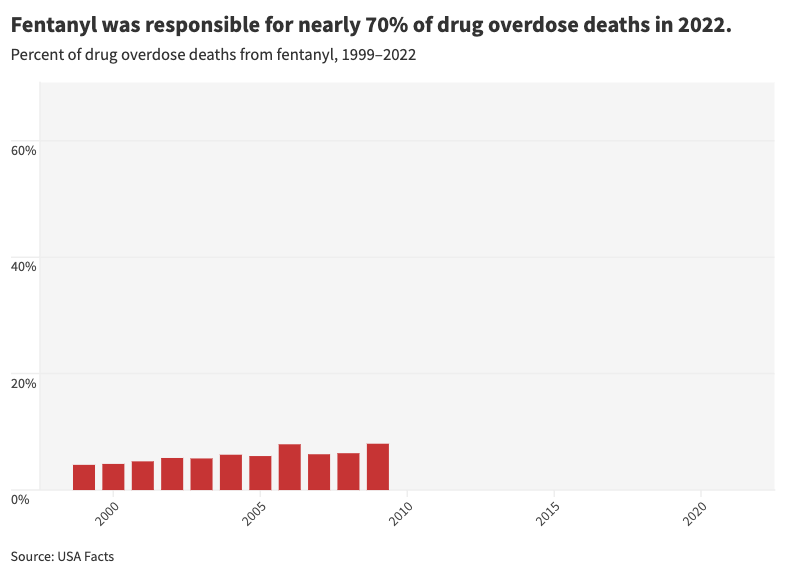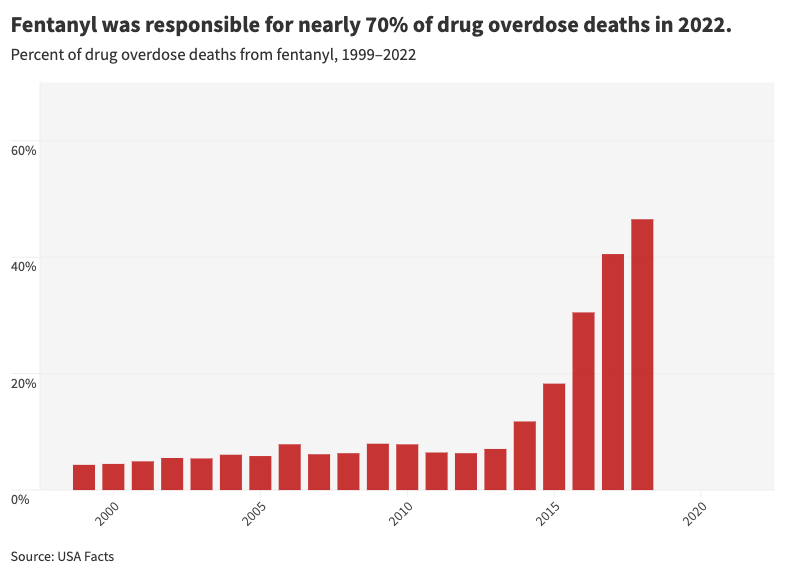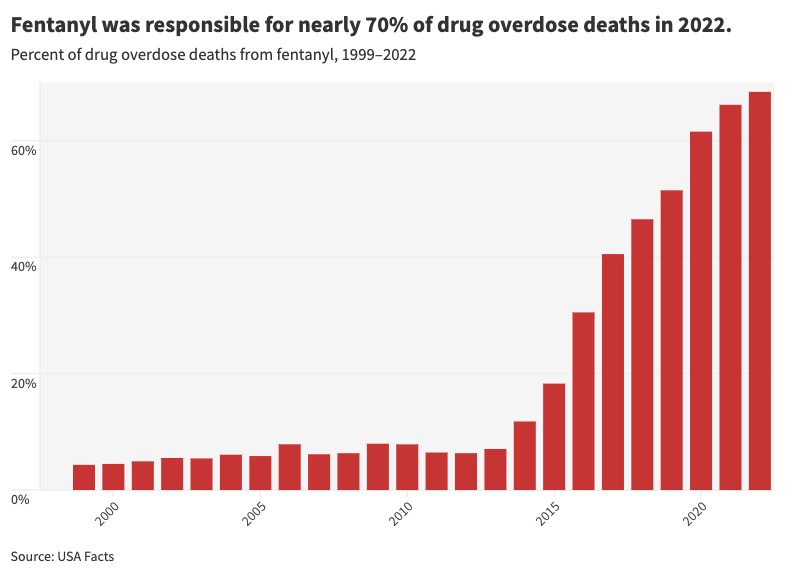Fighting the Fentanyl Epidemic
Flattening the curve

What is Fentanyl?
Fentanyl is a synthetic opioid used to manage severe pain and induce anesthesia under medical supervision. Appearing on the scene in the 1960s after approval by the U.S. Food and Drug Administration (FDA), fentanyl had a litany of useful medical purposes. Known for its potency, "It is approximately 100 times more potent than morphine and 50 times more potent than heroin as an analgesic." (DEA)
How is Fentanyl used?
Starting in 2011, illicit recreational use of fentanyl began to rise. Fentanyl can be used recreationally in a variety of ways, including snorting/sniffing, smoking, injection, and taken orally. Its effects on the body are similar to other opioids, including sensations of euphoria, relaxation, pain relief, and sedation. It comes in many different forms, primarily as a pill or powder. (DEA)
Is Fentanyl lethal?
In the last ten years, there has been a growing presence of illegally manufactured fentanyl and other synthetic opioids in the illicit drug market. This surge in available fentanyl and other similar compounds has significantly contributed to the alarming increase in drug overdose fatalities in the United States, as reported by the DEA. (DEA)
"Overdose may result in stupor, changes in pupillary size, cold and clammy skin, cyanosis, coma, and respiratory failure leading to death. The presence of triad symptoms such as coma, pinpoint pupils, and respiratory depression are strongly suggestive of opioid poisoning." (DEA)

Fentanyl ended the lives of over 200 Americans every single day in 2022. (USA Facts)
With deaths from other illicit drugs falling, fentanyl has become the deadliest drug, by far!

Fentanyl-related overdose deaths have reached a critical level, a major contributor to the alarming overdose rates in the United States. Illicitly manufactured fentanyl and its analogs are often mixed with other drugs, making it exceptionally dangerous due to the difficulty in controlling dosages and the high risk of accidental overdose.
The statistics surrounding fentanyl-related overdose deaths are deeply concerning and reveal a distressing trend. In the United States, for instance, the National Institute on Drug Abuse reported that in 2022, there were reportedly 109,680 drug-related overdose deaths. Fentanyl accounted for over two-thirds of all drug overdose deaths that year, marking a continued increase from previous years. The death rate due to fentanyl overdoses has seen a dramatic rise over the past decade. In 2010, there were approximately 3,007 deaths attributed to synthetic opioids, whereas by 2022, this number had surged to approximately 73,654, representing an exponential increase. (NIDA)
Comparatively, when we examine the death rate associated with fentanyl overdose in relation to other drugs in the opioid class, it becomes evident that fentanyl's lethality surpasses that of its counterparts. While prescription opioids like oxycodone and hydrocodone have also played a significant role in the opioid epidemic, the illicit production and heightened potency of fentanyl make it exceptionally lethal. Heroin, another opioid, has historically contributed to overdose deaths but has seen a decline in use as fentanyl has become more prevalent. Cocaine and methamphetamine-related deaths, while significant, do not approach the same levels as fentanyl. (NIDA)
These morbid statistics underscore the urgency of addressing the illicit production and distribution of fentanyl which has become known as the fentanyl epidemic. The devastation caused by this synthetic opioid affects communities nationwide, and concerted efforts are needed to combat its impact comprehensively.
“Fentanyl is the single deadliest drug threat our nation has ever encountered. Fentanyl is everywhere. From large metropolitan areas to rural America, no community is safe from this poison. We must take every opportunity to spread the word to prevent fentanyl-related overdose death and poisonings from claiming scores of American lives every day.”
- DEA Administrator Anne Milgram (DEA)
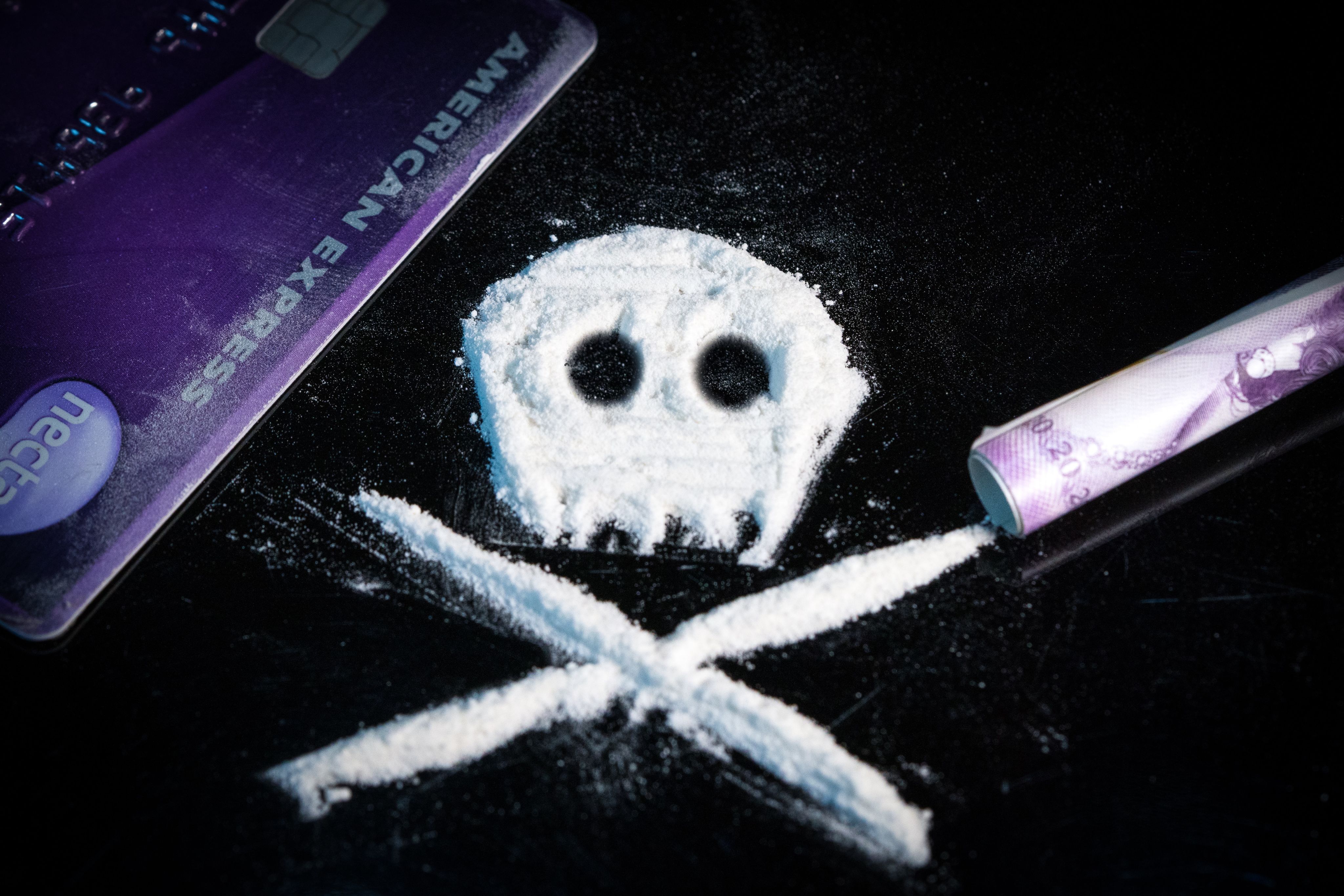

Photo by Karim Ghantous on Unsplash
Photo by Karim Ghantous on Unsplash
So far in 2023, the DEA has seized:
Over 62,400,000 fentanyl pills
Over 9,700 lbs of fentanyl powder
A lethal dose of fentanyl is only 2 mg
Over 400 million lethal doses
That is enough to fentanyl to kill every single American!
7 out of 10 illicit pills tested by the DEA contain deadly amounts of Fentanyl, and you would never even know it!
Fentanyl is everywhere, and it continues to grow
Source: DEA

Where does all this illicit Fentanyl come from?

The illicit smuggling of fentanyl into the United States has played a significant role in the fentanyl-related overdose crisis, contributing to the alarming statistics and trends associated with this synthetic opioid. The U.S. Drug Enforcement Administration (DEA) reported that the majority of illicit fentanyl in the U.S. is believed to originate from foreign sources, with China, Mexico, and Canada emerging as key players in this illicit trade. (DEA)
China has historically been a major source of precursor chemicals and illicitly manufactured fentanyl, often sold through online marketplaces. Authorities in both China and the United States have made efforts to curb this illicit trade. The implementation of stricter regulations in China has resulted in a decrease in the direct export of fentanyl-related substances to the U.S. However, illicit manufacturers have adapted by altering the chemical structures of fentanyl analogs, making them more challenging to detect and regulate. (DEA)
Mexico has also played a pivotal role in the illicit fentanyl trade, with drug cartels increasingly involved in its production and distribution. The proximity of Mexico to the United States provides a logistical advantage, making it easier to smuggle fentanyl across the border. The DEA has noted a sharp increase in seizures of fentanyl at the U.S.-Mexico border, highlighting the scale of the issue. (DEA)
Canada, too, has faced challenges with illicit fentanyl, often trafficked into the United States through cross-border smuggling. Although Canada has implemented measures to regulate the pharmaceutical fentanyl market, illicit manufacturers have exploited legal loopholes by producing fentanyl analogs. (DEA)
According to the DEA, the vast majority of illicitly manufactured fentanyl originated from foreign sources. The rapid increase in seizures of fentanyl at the border underscores the persistence of smuggling operations. So far in 2023, U.S. Customs and Border Protection (USCBS) has seized over 25,600 pounds of fentanyl, a significant rise from previous years. (USCBS)
Efforts to combat the illicit smuggling of fentanyl involve international cooperation, increased border security measures, and regulatory changes to control precursor chemicals. The challenge lies in staying ahead of the ever-evolving tactics employed by traffickers and manufacturers, highlighting the need for ongoing vigilance and collaboration between nations to address this global crisis effectively.
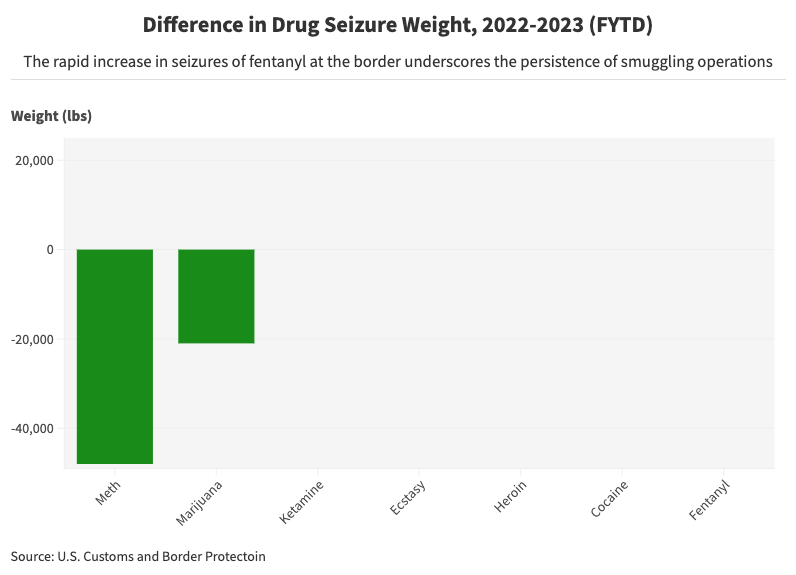
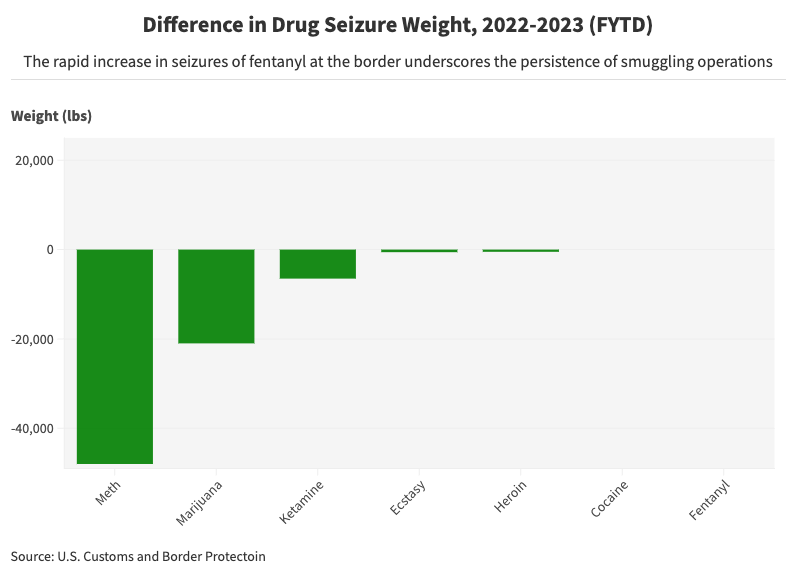
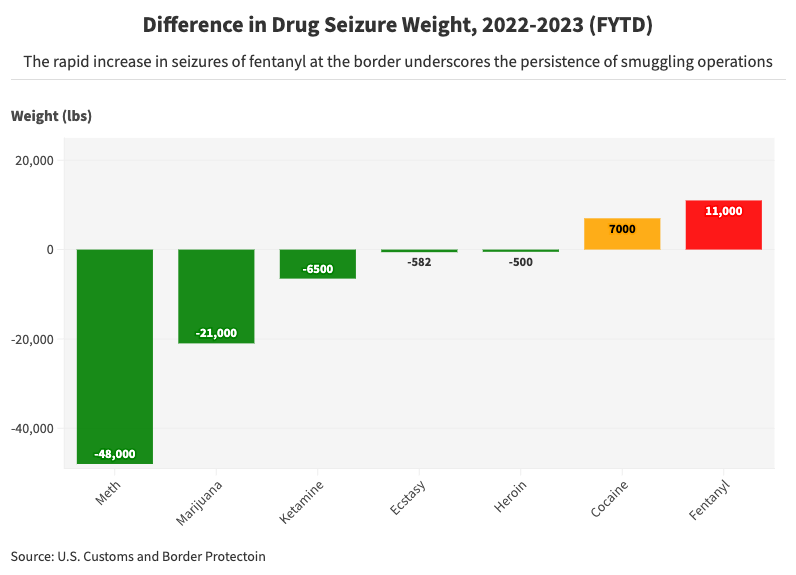
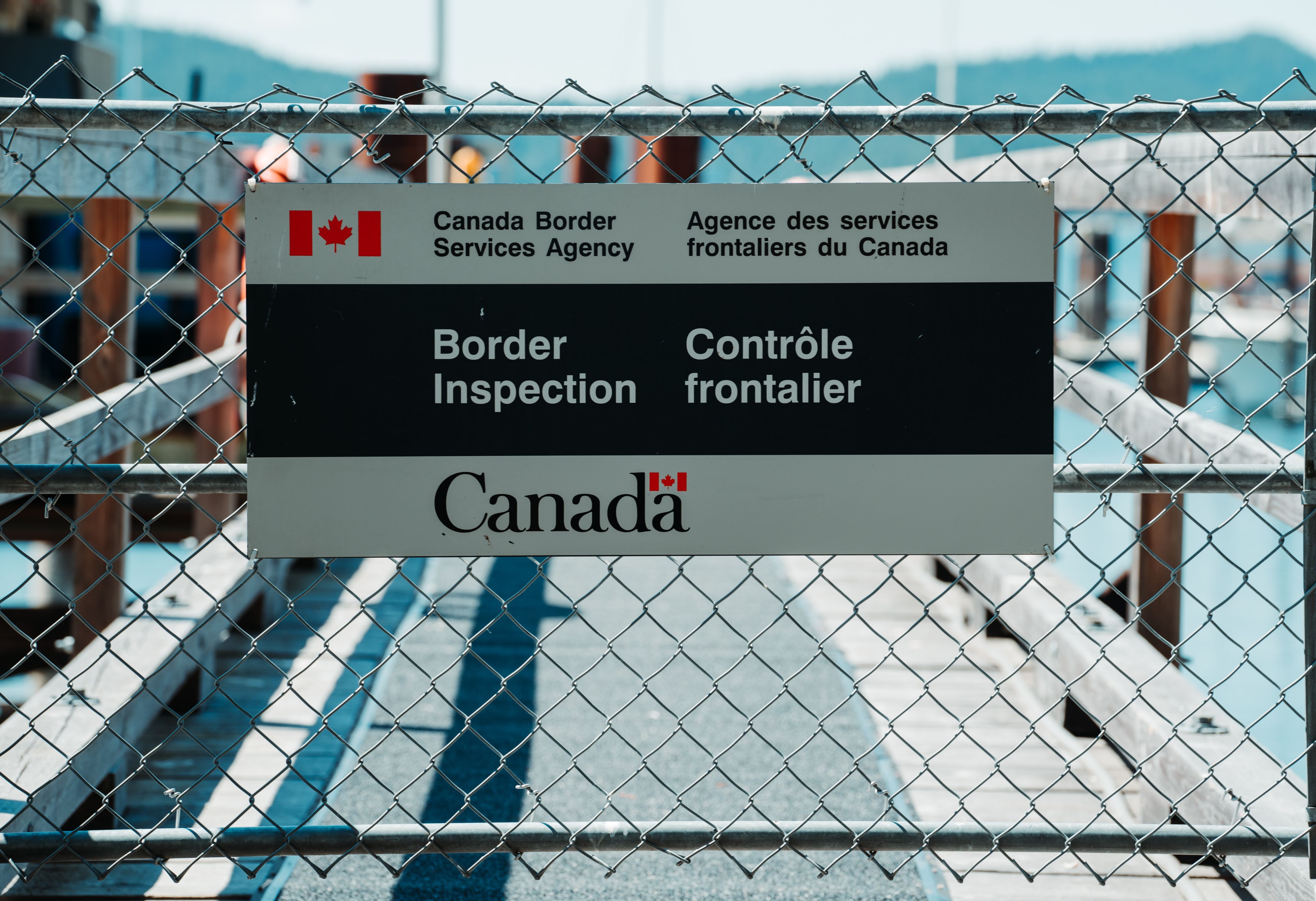
Photo by Hermes Rivera on Unsplash
Photo by Hermes Rivera on Unsplash
3. CANADA
Fentanyl arrives in Canada and is processed into different forms, including getting laced into other drugs. It is then smuggled across the Canadian border into the United States. This is the third largest source.
source: DEA

Photo by Greg Bulla on Unsplash
Photo by Greg Bulla on Unsplash
2. MEXICO
Drug cartels and smugglers move large quantities of fentanyl across the Mexican border into the United States in a variety of different forms. This is the second largest source.
source: DEA
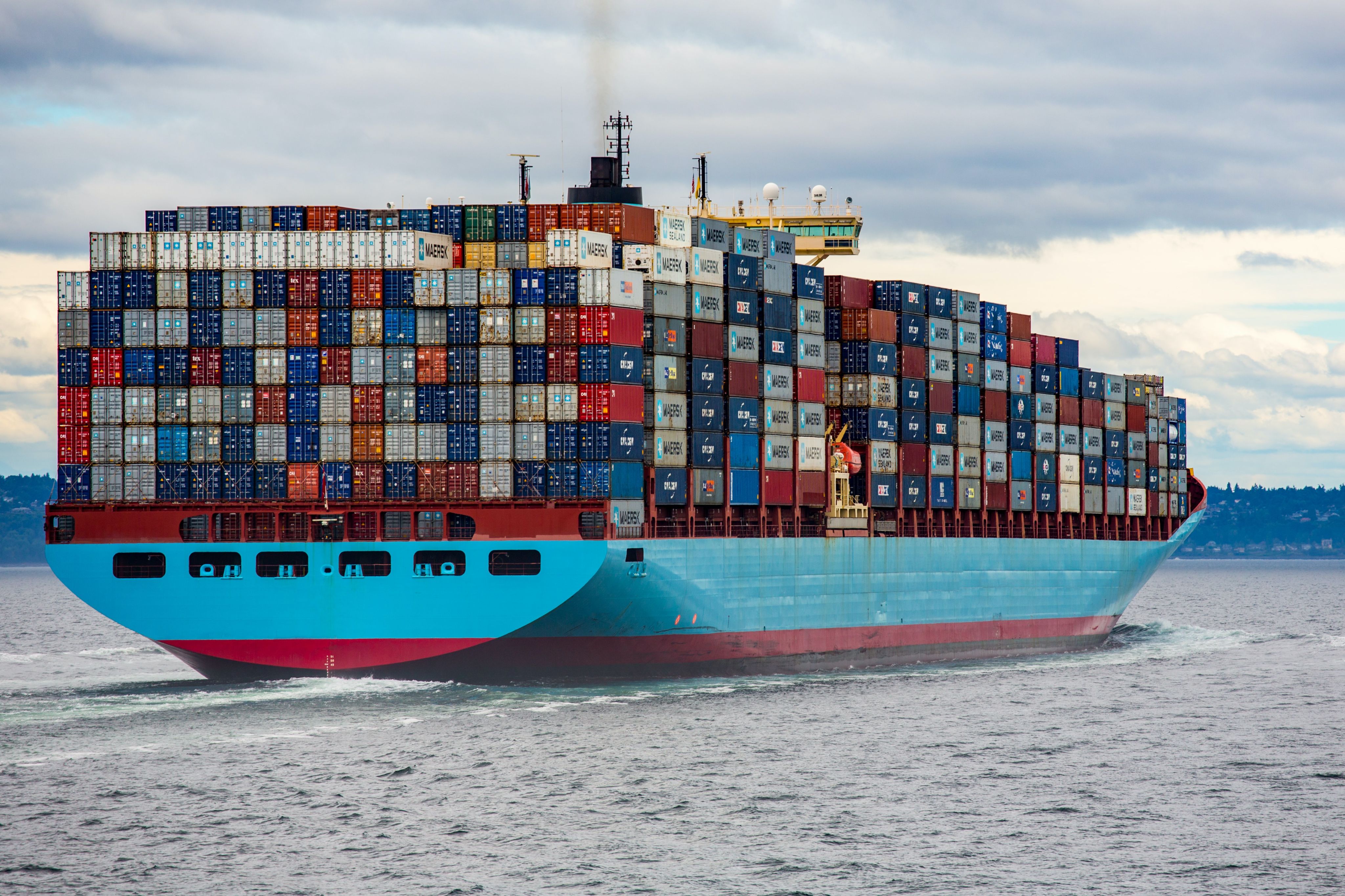
Photo by Ian Taylor on Unsplash
Photo by Ian Taylor on Unsplash
1. CHINA and INDIA
Fentanyl is smuggled into the west coast from primarily China and India. China is currently the largest supplier of all fentanyl-related substances in the United States.
source: DEA
Join the community stand against Fentanyl

Photo by Brett Jordan on Unsplash
Photo by Brett Jordan on Unsplash
Harm Reduction
Naloxone saves lives!
Naloxone is an FDA approved drug that counteracts opioid-related overdose. It can save lives in the event of an overdose from drugs such as fentanyl, heroin, morphine, and other opioids. It is available for purchase over the counter nationwide. (SAMHSA)
It is a temporary solution. Anyone who is the recipient of naloxone still must seek immediate medical treatment!
In 2019, Naloxone saved over 50,000 lives. (CDC) As the fight against the fentanyl epidemic continues, Naloxone is the primary first response tool at the frontlines.

“The opioid and overdose crisis continues to evolve in dangerous and unpredictable ways, but scientific solutions that embrace innovative research and community connections offer the best hope for saving lives across America.”
NIH HEAL Initiative Director Rebecca G. Baker, Ph.D. (NIDA)

How can you help?

Photo by Brett Jordan on Unsplash
Photo by Brett Jordan on Unsplash
Stay Informed/Harm Reduction Resources

Photo by Aaron Burden on Unsplash
Photo by Aaron Burden on Unsplash
Advocate for change: Sign Petitions

Photo by Louis Velazquez on Unsplash
Photo by Louis Velazquez on Unsplash

References
ABC News. (May 2023) Fentanyl Overdose Deaths Surged 279% Since 2016 While Heroin Deaths Fell: CDC. https://abcnews.go.com/Health/fentanyl-overdose-deaths-surged-279-2016-heroin-deaths/story?id=99008519
CDC (Center for Disease Control and Prevention). (February 2023). Provisional Drug Overdose Death Counts. https://www.cdc.gov/nchs/nvss/vsrr/drug-overdose-data.htm
DEA (Drug Enforcement Administration). (February 2023). Fentanyl. https://www.dea.gov/onepill
DEA (Drug Enforcement Administration). (April 2023). Fentanyl Awareness. https://www.dea.gov/fentanylawareness
DEA (Drug Enforcement Administration). (January 2020). Fentanyl Flow to the United States. https://www.dea.gov/sites/default/files/2020-03/DEA_GOV_DIR-00820%20Fentanyl%20Flow%20in%20the%20United%20States_0.pdf
SAMHSA (Substance Abuse and Mental Health Services Administration). (September 2023). Naloxone. https://www.samhsa.gov/medications-substance-use-disorders/medications-counseling-related-conditions/naloxone
The Hill. (March 2023). Teen Overdose Deaths Have Doubled in Three Years. Blame Fentanyl. https://thehill.com/policy/healthcare/3917058-teen-overdose-deaths-have-doubled-in-three-years-blame-fentanyl
National Institute on Drug Abuse. (June 2023). Drug Overdose Death Rates. https://nida.nih.gov/research-topics/trends-statistics/overdose-death-rates
National Institute on Drug Abuse. (December 2021). Fentanyl. URL: https://nida.nih.gov/research-topics/fentanyl
National Institute on Drug Abuse. (December 2022). NIH Launches Harm Reduction Research Network to Prevent Overdose Fatalities. https://nida.nih.gov/news-events/news-releases/2022/12/nih-launches-harm-reduction-research-network-to-prevent-overdose-fatalities
U.S. Customs and Border Protection. (September 2023). Drug Seizure Statistics. https://www.cbp.gov/newsroom/stats/drug-seizure-statistics
USA Facts. (September 2023). Are Fentanyl Overdose Deaths Rising in the US? https://usafacts.org/articles/are-fentanyl-overdose-deaths-rising-in-the-us/

